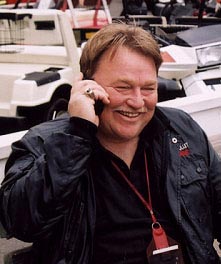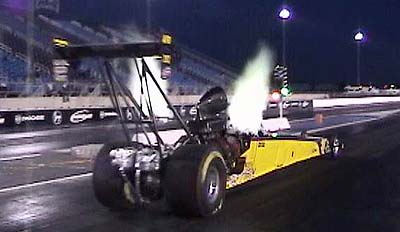|


2/10/04
IHRA deserves props for Top
Fuel change

 ay
what you want about the IHRA but don't ever accuse them
of not taking chances in their efforts to improve the entertainment
package they present to their fans. ay
what you want about the IHRA but don't ever accuse them
of not taking chances in their efforts to improve the entertainment
package they present to their fans.
During the five years or so that Bill Bader has held the
reins at IHRA they've added and subtracted more classes
and rules than the NHRA has in five decades. This year the
Norwalk, Ohio-based sanctioning body has made even more
changes. They added Scooter Peaco who, as the director of
race operations, apparently will take over the day-to-day
operations of the sanctioning body from President Bill Bader.
One of Mr. Peaco's first major decisions was to change IHRA's Top Fuel
rules to make unblown, nitro-burning dragsters legal for IHRA's Top
Fuel class. In an interview published last issue in this magazine,
Peaco commented that if he could be convinced injected nitro cars would
be competitive, not just be sixth, seventh or eighth qualifiers or
first round "cannon-fodder," he would consider adding them to IHRA's
Top Fuel class. After conversations with several racers, including NHRA
T/AD star Keith Stark, evidently Peaco and Bader were persuaded the
cars could be competitive with the blown fuel cars and the class was
added for the 2004 IHRA season.
The question the racers, fans and track owners have is can the injected
nitro cars be entertaining to the fans paying to see a Top Fuel show
and will they be competitive? The racers seem to think so despite the
fact that the quickest pass ever for one of these cars is Gary Ormsby
Jr.'s 5.13 lap and Michael Gunderson holds the Top Speed mark at 280
mph. Despite those numbers, most of the cars run in the low 5.30's.
The racers believe that with the new IHRA rules, which allow injected cars
to weigh a minimum of 1,950 lbs., increase engine size to
a max of 500 ci, use any rear gear ratio, install top fuel
clutch management systems and burn 100% nitro, it is feasible
that these cars could run in the 4's at over 300 mph.
Is this the formula that will allow injected nitro dragsters to go from
being 5.30 cars to 4.90 cars? Remember, the best official pass by one
of these cars is a 5.13. To break into the fours at speeds over 300 mph
the average racers will have to pick up just about a tenth and a half
over the best ever. For most racers the jump to the fours will require
more than four-tenths improvement on their best efforts.
Hall-of-Fame tuner Dale Armstrong has said many times that he feels
that four-second laps for injected nitro cars are a very real
possibility and he has been helping Keith Stark with his nitro-injected
combination for a long time. According to Stark, the main problem they
have to solve to get these cars to run consistently in the fours is to
keep all eight cylinders lit for 1320 feet.
"I ran a 5.26 at 277 mph last year at Chicago and the engine put a
cylinder out three seconds into the run," Stark said. "If it (the
engine) had run on all eight cylinders to the stripe, the data-logger
says it would have run a 5.15."
It is not unreasonable to take the numbers that Stark, Ormsby and
Gunderson have recorded and conclude that -- with the aid of less
weight, more cubic inches (Stark currently runs a 430 cubic inch
engine), and a clutch management system to help load the engine -- on a
perfect pass under perfect conditions, one of those cars could make a
four-second, 300-mph pass.
In Starks's opinion it won't be in an NHRA-legal car, though. He believes that
racers won't be able to switch back and forth between the
two sanctioning bodies easily.
 "I
don't think racers will have to build a car specifically
for competition in IHRA Top Fuel," said Stark. (He's currently
having Spitzer Race Cars back-halve his car so that he can
install a "Cannon" clutch management system.) He thinks
most of the cars out there have the engine so far forward
that they will be able to install clutch systems without
modifying their cars. He doesn't believe that he or anyone
else can build a car that will weigh 1,900 lbs. "I think
that you can get them to 1,950 lbs but not much lighter
than that." "I
don't think racers will have to build a car specifically
for competition in IHRA Top Fuel," said Stark. (He's currently
having Spitzer Race Cars back-halve his car so that he can
install a "Cannon" clutch management system.) He thinks
most of the cars out there have the engine so far forward
that they will be able to install clutch systems without
modifying their cars. He doesn't believe that he or anyone
else can build a car that will weigh 1,900 lbs. "I think
that you can get them to 1,950 lbs but not much lighter
than that."
Currently there seem to be at least a half-dozen of these cars planning
to try Top Fuel. I hear that besides Stark, others like Mike Dakin, Art
Gallant, Ken Hirata and Michael Gunderson, just to name a few, have
said they would give it a try. In fact, when he was told that IHRA was
allowing them to compete, former IHRA Top Fuel World Champ Paul Romine
expressed interest in returning to IHRA Top Fuel competition with an
injected nitro car.
This move by IHRA will bring some welcome changes and attention to
their Top Fuel class that has been completely dominated by one racer
for the last four years and had only about three or four really
dependable cars capable of a four-second, 300-mph pass during that
time. If it does nothing else, the change will give the media and fans
something different to watch and talk about. And there is one other
thing that could really add some "juice" to this deal.
There is a rumor that IHRA might allow nitrous if it would help make
the combination effective. If IHRA were to do this it would be a master
stroke as far as creating excitement in the class. Young fans who know
nothing about nitro all know nitrous. That might get them interested in
Top Fuel. On top of that, there would be an atmosphere in Top Fuel
similar to what has kept Pro Mod so interesting to fans. Nitro/nitrous
cars versus blower cars in Top Fuel!
There doesn't appear to be a downside to what IHRA is attempting.
They need more cars in the class. They need more fuel cars
making laps on Friday or Saturday night. The class needs
new drivers and teams (can you say Ashley Force!). This
radical move by IHRA seems a sure bet to do all of that.
|